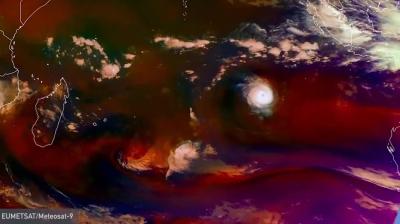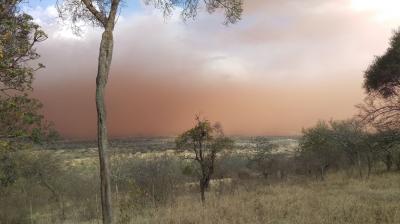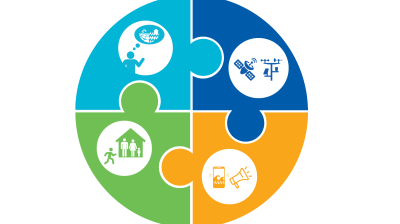Hurricanes are inevitable, but disasters are not: OpEd
The experience of Hurricane Beryl, the earliest Category 5 hurricane on record in the Caribbean, provides us with important lessons for the rollout of Early Warnings for All initiative.

Hurricane Beryl, the strongest June hurricane ever recorded in the Atlantic, was a powerful reminder of how a single landfalling tropical cyclone can turn back years of development. Beryl was fuelled by warm ocean temperatures and intensified rapidly - an increasingly frequent phenomenon as a result of climate change.
But some successes also emerge: fewer lives were lost to Beryl compared to past hurricanes, like Maria in 2017. This was the result of years of investment in strengthening early warning systems by the Caribbean nations and support from regional and international bodies.
In an OpEd published in the Trinidad & Tobago Guardian, Kamal Kishore of the UN Office for Disaster Risk Reduction, Elizabeth Riley of Caribbean Disaster Emergency Management Agency (CDEMA), and Celeste Saulo of the World Meteorological Organization call for continued efforts to strengthen multi-hazard early warning systems in the Caribbean, so that we can achieve the goals of the Early Warnings for All initiative by 2027.
Hurricane Beryl has entered the history books as the strongest hurricane ever recorded in the Atlantic Ocean during the month of June.
The occurrence of such a powerful storm early in the hurricane season was inevitable as climate change continues to create more extreme weather events. However, what is not inevitable is that people need to die or suffer because of these weather events.
Indeed, a success story in the midst of the destruction inflicted by Hurricane Beryl on the islands of the Caribbean is that fewer people died compared to similar past hurricanes, such as Hurricane Maria in 2017 or Hurricane Ivan in 2004.
This is the result of years of investment in strengthening early warning systems by the Caribbean nations and support from regional bodies such as the Caribbean Disaster Emergency Management Agency, the Caribbean Meteorological Organization, and the Caribbean Institute for Meteorology and Hydrology, as well as the World Meteorological Organization (WMO) Hurricane Committee and WMO designated Regional Specialized Meteorological Center for tropical cyclones, operated by the US National Hurricane Center.
We must continue to strengthen multi-hazard early warning systems in the Caribbean, through efforts such as the recently announced Climate Risk Early Warning Systems (CREWS) Caribbean 2.0 project, if we are to achieve the goals of the Early Warnings for All initiative by the end of the year 2027.
Nevertheless, while disaster deaths are on a downward trend, the cost of disasters is growing. Increasing social and economic costs is a problem that all countries face but is most acutely felt in Small Island Developing States (SIDS).
It might be months before we know the total cost of the disaster caused by Hurricane Beryl, but early indications point to an extremely costly disaster. Beryl affected over 11,000 persons in the Grenadine Islands of Grenada and St. Vincent, disrupting lives, livelihoods, and life chances. In St. Vincent and the Grenadines, reportedly 90 per cent of homes on Union Island were destroyed or severely damaged.
While some countries can reduce their disaster exposure by moving economic assets away from shorelines, this is not an option for small island states that are fully exposed. This means their only viable option is to enhance social and economic resilience as well as the physical resilience of their homes, businesses, and infrastructure.
Developed countries must keep the promises they made to double climate adaptation financing to at least $40 billion a year by 2025 and adequately capitalize the Loss and Damage Fund.
The recently adopted Antigua and Barbuda Agenda for SIDS is a powerful political instrument that along with global partnerships, such as the Coalition for Disaster Resilient Infrastructure (CDRI), can be an invaluable resource to such countries, supporting result delivery under regionally driven imperatives such as the Comprehensive Disaster Management Strategy in the Caribbean. The UN Office for Disaster Risk Reduction has been working with CDRI to help countries stress-test their infrastructure systems and identify vulnerabilities.
And while integrating resilience into new infrastructure adds around 3 percent to the overall investment costs, this amount is minuscule compared to the long-term benefits gained in reduced damage and service disruptions.
Research from the Global Center on Adaptation has shown that resilient infrastructure could deliver up to $12 for every dollar invested.
Despite this great return on investment, financing, including for resilient recovery is a burden for many developing countries, especially SIDS that are already saddled with large debts and have limited fiscal space. That is why developed countries must keep the promises they made to double climate adaptation financing to at least $40 billion a year by 2025 and adequately capitalize the Loss and Damage Fund.
This is only fair considering that countries, such as those in the Caribbean, contributed the least to the creation of the climate crisis but continue to pay the greatest costs.
We hope that the true legacy of Hurricane Beryl will not be its record-breaking strength or the amount of destruction it caused, but that it was a turning point for the world. We need to pivot from passively accepting that disasters will occur to actively preventing them through investment in disaster risk reduction. Otherwise, every hurricane will inevitably lead to disaster.
By Elizabeth Riley, Celeste Saulo and Kamal Kishore
*By Elizabeth Riley is the Executive Director of the Caribbean Disaster Emergency Management Agency (CDEMA), Professor Celeste Saulo is the Secretary-General of the World Meteorological Organization (WMO), and Kamal Kishore is the Special Representative of the UN Secretary-General for Disaster Risk Reduction and Head of the UN Office for Disaster Risk Reduction (UNDRR).
- Член ВМО:
- Jamaica ,
- British Caribbean Territories








